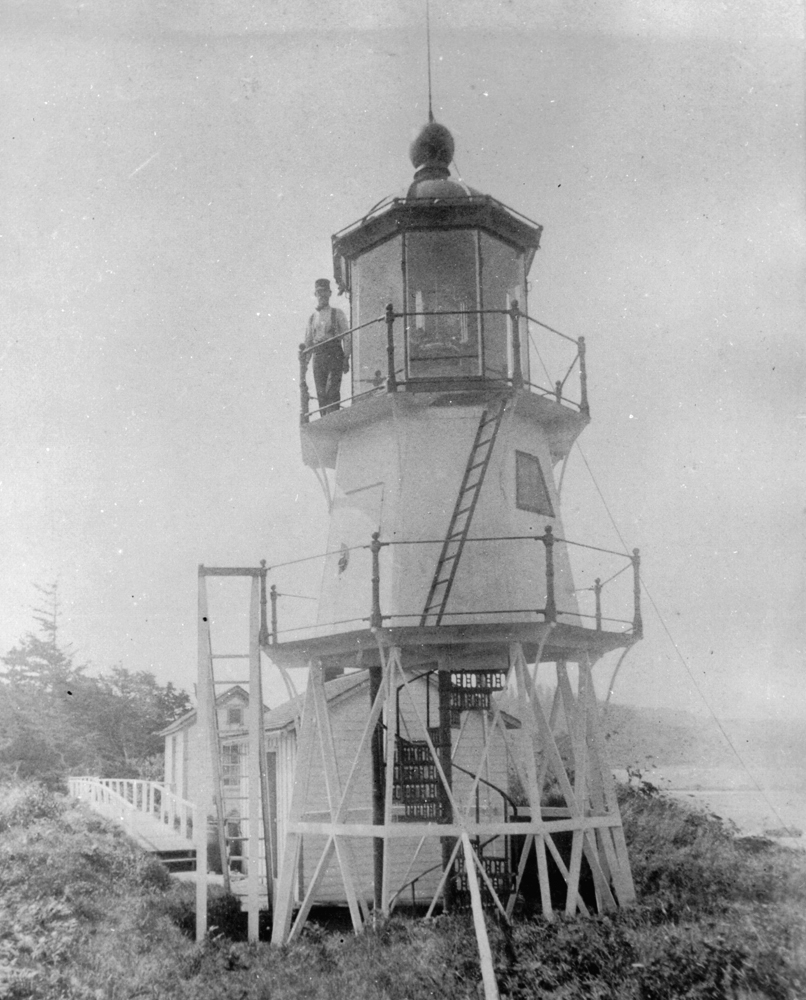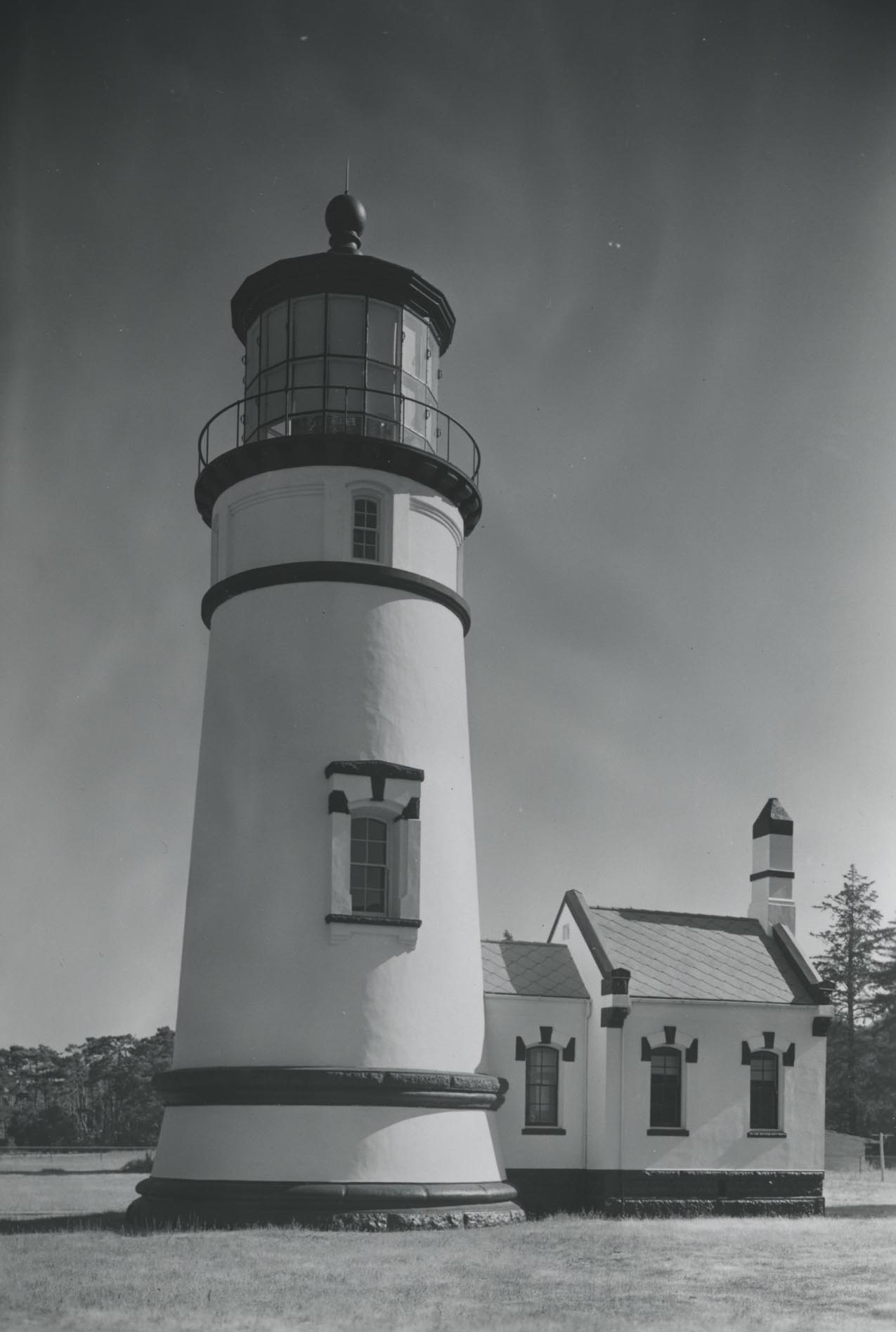The Coquille River Lighthouse, which is adjacent to the Coquille River, began operation in 1896 and is part of Bullards Beach State Park near Bandon on the south-central Oregon Coast. The lighthouse, the last government light built in Oregon, served to direct traffic into the Coquille River and as a light for mariners at sea. Unique among West Coast lighthouses in its architecture, it is an elongated octagonal shape with arched window heads.
EuroAmerican settlers began arriving in the present-day Bandon area by 1850. Nearby, the Coquille River—named for the Coquille Indians who lived there—emptied into the Pacific, and settlers upstream in the Coquille Valley wanted to ship their timber and produce to the coast on the river. The problem was the Coquille’s bar, where the river met the sea. It was notorious for rocks, shifting sands, and water that was sometimes only three feet deep, and many ships in the mid-nineteenth century simply bypassed the river. The first ocean-going sailing vessel to brave the Coquille’s bar was probably the schooner Twin Sisters in 1859, traveling some forty miles upriver to sell merchant goods.
In 1880, Congress funded a jetty on the south side of the entrance to the Coquille River, aiming to increase to ten feet the depth of water over the bar. About five hundred yards of the jetty had been built by 1889, increasing the bar depth to a little over five feet. On occasion, the river became even more accessible. Bar depth was ten to twelve feet at high water in March 1887, for example, according to the 1889 Coast Pilot. These modest improvements in the river channel led to more regular ship traffic into the Coquille—166 ships between 1883 and 1885. Larger ships could navigate the river for about forty miles.
Elected officials took notice of the increasing commercial traffic and the shippers’ needs. In 1886, Oregon Representative Binger Hermann introduced a bill in Congress to establish a lighthouse at the river mouth; the U.S. Lighthouse Board requested the funds in 1890. Congress appropriated $50,000 for a Coquille River lighthouse in 1891 and authorized construction, but it took four years for the project to get underway due to incomplete plans and local landowners’ reluctance to sell.
Work began in spring 1895 with leveling the top of Rackliff Rock, the site for the lighthouse. The foundation was of quarried local stone, and the lighthouse was made of brick covered with stucco. The keepers’ dwelling was a wood-frame duplex connected to the lighthouse by a long wooden walkway across the sand. Each side of the duplex had three bedrooms, a sitting room, and a dining room. A barn was built nearby for cows and chickens.
Head keeper James F. Barker first lit the fourth-order Fresnel lens on February 29, 1896. The lighthouse had a fixed white signal, with a two-second eclipse each half-minute, that could be seen for thirteen miles. It also had a first-class Daboll fog signal, which included a 5,000-gallon water tank atop a trestle foundation, built in 1898. In 1907, an oil-powered compressed air plant replaced the steam engine that powered the fog signal.
Coquille River Lighthouse personnel did not suffer from isolation. Nearly every day keepers rowed across the river to the town of Bandon for supplies, and lighthouse children attended school there. But the sandspit that the lighthouse was built on was bleak, and wind and blowing sand were constant problems. In 1912, the Lighthouse Board recommended moving the lighthouse to the south side of the river, as more ships were using the South Jetty channel. Congress appropriated $6,000 for the project in 1916, but shippers used to the lighthouse’s position successfully opposed the proposal. The lighthouse escaped the great fire of 1936, which consumed five hundred buildings in Bandon.
The U.S. Coast Guard took over the lighthouse in 1939 and determined it was no longer necessary. They placed an automated beacon on the end of South Jetty, removed the keepers’ dwelling, and abandoned the lighthouse. Oscar Langlois, who had come to the lighthouse in 1921 and was the longest-serving head keeper, presided over its closing.
The lighthouse was abandoned for twenty-four years until the Oregon Parks Division purchased the light station as part of the 1,289-acre Bullards Beach State Park (park land was acquired in sections between 1962 and 1985). The damage done to the lighthouse by coastal storms and vandals was too extensive for the Parks Division to undertake the restoration itself, but the U.S. Army Corps of Engineers and the State of Oregon collaborated on the three-year project beginning in 1976. The lighthouse opened to the public in 1979.
In 1991, a solar light was installed in the tower during the centennial of the City of Bandon. A second extensive restoration of the lighthouse, costing $600,000, became necessary in 2007, as winter storms had undermined the foundation. Bandon’s Mayor, the Executive Director of the Bandon Historical Society Museum, and other residents strongly opposed the new color scheme—light tan for the upper portion with a red base—arguing that pure white was the historically accurate color. But Oregon Parks and Recreation Department research discovered the lighthouse had been tan with a red base at some point between 1902 and 1928, as it is now once again. Coquille River Lighthouse continues to be a popular centerpiece of Bullards Beach State Park.
-
Coquille River Lighthouse.
Courtesy U.S. Coast Guard
Related Entries
-
![Bandon]()
Bandon
Located at the mouth of the Coquille River in Coos County, Oregon, Band…
-
![Cape Arago Lighthouse]()
Cape Arago Lighthouse
The Cape Arago Lighthouse sits on a small island off Cape Arago, south …
-
![Cape Blanco]()
Cape Blanco
Windswept Cape Blanco—situated at N 42˚50'08.12", W 124˚33'51.16"—is th…
-
![Umpqua River Lighthouse]()
Umpqua River Lighthouse
The Umpqua River Lighthouse, Oregon’s first, was built twice. The U.S. …
Related Historical Records
Map This on the Oregon History WayFinder
The Oregon History Wayfinder is an interactive map that identifies significant places, people, and events in Oregon history.
Further Reading
Davidson, George. Pacific Coast: Coast Pilot of California, Oregon and Washington. United States Coast and Geodetic Survey. Washington, D.C.: Government Printing Office, 1889.
Gibbs, James, with Bert Webber. Oregon’s Seacoast Lighthouses. Medford, Ore.: Webb Research Group, 1992.
Lighthousefriends.com. Coquille River Lighthouse. http://lighthousefriends.com/light.asp?ID=127
McCasland, Steve. “Paint job stirs up controversy.” The World, May 7, 2008.
Nelson, Ted, and Sharlene Nelson. Umbrella Guide to Oregon Lighthouses. San Luis Obispo, CA.: EZ Nature Books, 1994.
Pinyerd, David. Lighthouses and Life-Saving on the Oregon Coast. Charleston, SC.: Arcadia Publishing, 2007.





